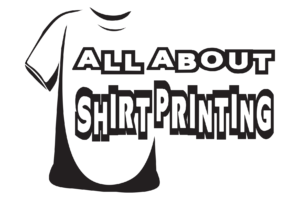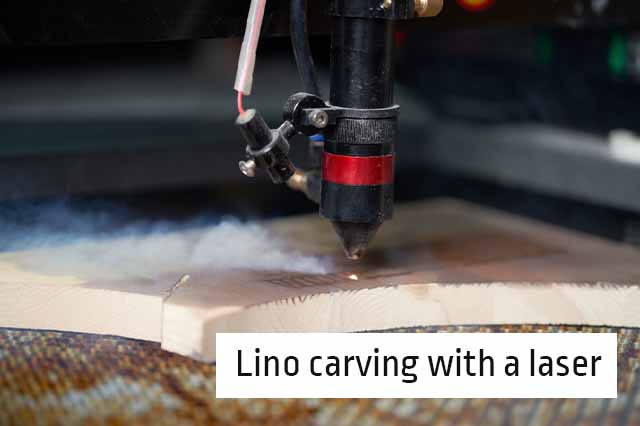Is it possible to carve lino with a laser? Lino carving can be a time consuming task. Those who would like to save carving time have a solution: a laser cutting plotter.
Lino prints are a great way to make stamps to print on t-shirts and paper. The process of making the stamp is not complicated, does not require a large financial investment and the stamps can be reused for a long time.
But, the carving of the stamp is done manually and therefore it requires working time and precision when trying to carve shapes with small or complex details. This reason makes me afraid that lino printing is not an industrial printing method in the field of shirts, but – can this be solved?
Lino carving with a laser
In recent years, the use of laser machines for cutting and engraving has increased. These machines are mainly used in the field of sign production, where they are used to cut perspective, aluminum, wood, lucobond and other materials. These machines are usually large and expensive, but over time smaller laser devices for home use began to be marketed. These devices appeal to the field of crafting, small businesses for the production of gifts or models.
Another use for these devices can be wood carving. The small laser devices often have more cutting or carving power than the industrial ones, so lino, which is a relatively soft material, can be perfect for them.
What is a laser plotter?
Laser cutting plotters are sophisticated machines that use lasers to carve and etch designs into a variety of materials, including wood, plastic, fabric, leather, paper and cardstock. This type of machinery has many uses in the manufacturing industry as it allows for precise cutting of intricate shapes and patterns with great accuracy. Laser cutting plotters use high-powered lasers to cut through a material by heating the material until it either evaporates or melts away. The laser is guided by a computer that can be programmed to create complex patterns and shapes.
The laser beam is typically focused on an area at least 0.1mm² in size, allowing it to achieve unbelievable precision in its cuts while maintaining speed due to the sheer power of the laser beam itself. This makes laser cutting plotters an extremely useful tool for creating highly detailed pieces without having to spend hours painstakingly carving them out by hand. Laser cutting plotters can also create 3D objects from flat sheets of material and can be used for artistic endeavors such as etching intricate designs onto surfaces or engraving logos or other artwork onto products.
In addition to its industrial applications, laser cutting plotters have become popular among hobbyists as well. Due to their precision and ease of use, they can be helpful when creating art projects such as jewelry, sculptures, models and decorations using various materials like paper or cardboard allowing users to craft intricate designs with just the press of a button. Furthermore, commercial manufacturers often offer kits that allow users to assemble their own DIY laser cutters inexpensively, allowing anyone with some technical knowledge to experiment with this technology without breaking the bank. Laser cutting plotters are machines that use laser beams to precisely cut, mark, and engrave a variety of materials such as paper, plastics, rubber, leather, acrylics and many more. They utilize advanced computer-aided manufacturing (CAM) technologies to quickly and accurately create two-dimensional designs. Laser cutting plotters are used in countless industries including engineering, construction, manufacturing and art.
Using a laser beam with a diameter of .004″ to .015″, the cutting plotter can produce cuts with extremely high accuracy and complex shapes that would not be possible with traditional cutting methods. The result is an extremely clean cut without any burrs or surface damage along the edges of the cut material. The ability for these machines to accommodate intricate designs makes them a popular choice for designers requiring creative solutions from their materials.
The laser cutting plotter also offers a wide range of benefits when compared to other forms of printmaking such as lino printing. Unlike lino printing which relies on carving images into wood or linoleum blocks or plates which then require manual inking and pressing onto paper or fabric, laser cutting plotters are capable of producing much higher resolution images with greater detail and precision. Additionally, they require significantly less time to complete complex projects than traditional methods due to their ability to rapidly process data from computer aided design (CAD) files or scanned images. With highly-precise lasers guided by CAM software, any shape can be replicated with accuracy down to 0.001″. As a result, designers can create highly detailed works that would have been impractical before the advent of this technology.
Overall, laser cutting plotters offer unparalleled precision and speed while creating two-dimensional designs out of various materials that were previously difficult to work with using other traditional methods. Through its advanced features combined with its ease of use and accessibility for hobbyists and professionals alike it has become an invaluable tool for creating intricate artwork as well as efficient manufacturing solutions across numerous industries worldwide.
Lino carving with a laser
In recent years, the use of laser machines for cutting and engraving has increased. These machines are mainly used in the field of sign production, where they are used to cut perspective, aluminum, wood, lucobond and other materials. These machines are usually large and expensive, but over time smaller laser devices for home use began to be marketed. These devices appeal to the field of crafting, small businesses for the production of gifts or models.
Another use for these devices can be wood carving. The small laser devices often have more cutting or carving power than the industrial ones, so lino, which is a relatively soft material, can be perfect for them. Note that you need to choose lino or rubber suitable for laser cutting.
How to carve lino using a laser?
The laser engraving process is similar to the normal work process by a laser plotter, but there are some highlights that you should pay attention to:
First of all, pay attention to the thickness of the carving required – when printing on shirts it is better for the carving to be as deep as possible because the fabric is not rigid and therefore when you press the lino to it the fabric around the print area may get dirty with color.
Secondly, note that the material you are going to cut is suitable for working with a laser. If you haven’t found the full lino for this, you can work with laser cutting rubber or wood.
Third thing – pay attention to the cut settings. Not every material requires the same laser power.

